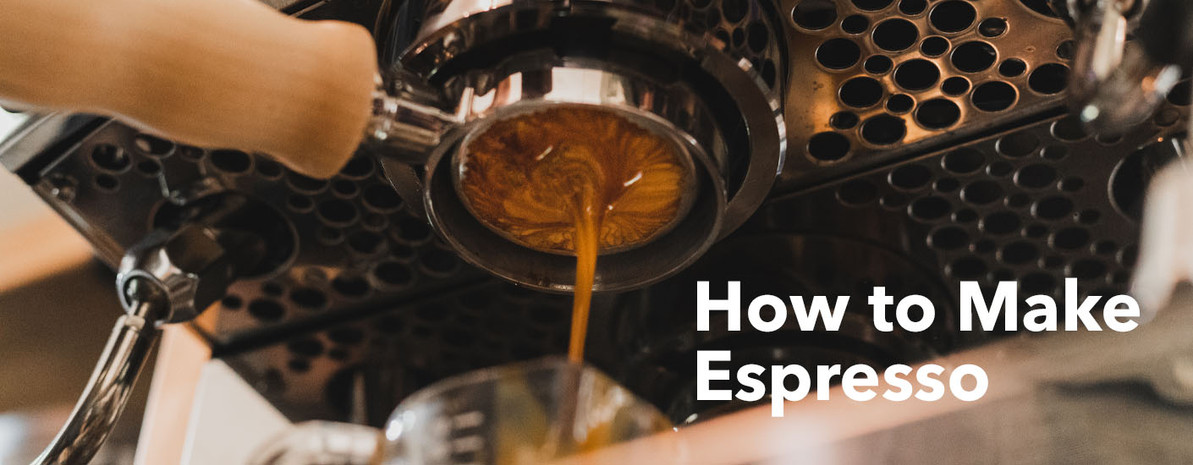How to Make Espresso
You know what espresso is, and you know it's for you. But where do you start? With this beginner's guide, we'll point you in the right direction – and we promise you'll like where this is going.
So you’ve decided that you’re ready to make espresso. A noble endeavor, surely, and one not to be undertaken lightly. Although espresso preparation has evolved almost constantly since the first espresso machine was patented over a century ago, there are a few pillars of the process that we should adhere to if you’re hoping to make consistently delicious coffee. This article is dedicated to introducing you to the important brewing variables, the tools required, and the process for making your own exceptional espresso, all capped off with some troubleshooting tips for easily diagnosing common problems with your shots. Read on, friend, and let’s talk about one of my very favorite topics—espresso!
Brewing Variables
Before we get into espresso prep there are some important variables to address. Similar to brewing drip coffee, these variables will determine the overall quality of our beverage by controlling the amount of strength and extraction achieved in the final cup; some of those variables are shared directly with drip coffee, but a couple of them will be specific to espresso preparation. Let’s break these down first, then we’ll talk about how to put them into practice.
Water: Your espresso can only taste as good as the water you start with. Sediment and scale in your boiler, water that’s too hard or too soft, or water with noticeable flavors or odors of its own will all seriously hobble your ability to make delicious coffee. We recommend picking up a water test kit if you aren’t familiar with the quality of your water at home and then comparing those results with the water standards from the Specialty Coffee Association. If your water is seriously out-of-line with those standards there are lots of water treatment options available—sometimes all you need is a simple carbon filter, but in other instances you might want to make your own water to fill your reservoir, or even look at more complete filtration systems for a machine you’ve plumbed into your home or office. We love to talk about water quality with folks, so definitely don’t hesitate to give us a buzz with any questions you have!
Grind: Roasted coffee has to be cut into smaller pieces before it’s usable for brewing. Espresso requires a finer grind consistency than almost any other preparation method, with particles typically ending up quite a bit finer than table salt. For the consistency and fine particle size necessary to brew espresso, we recommend only using a burr grinder and never a blade grinder. If you're unsure what grinder is right for you, check out our blog that lays out the features of all our espresso grinders.
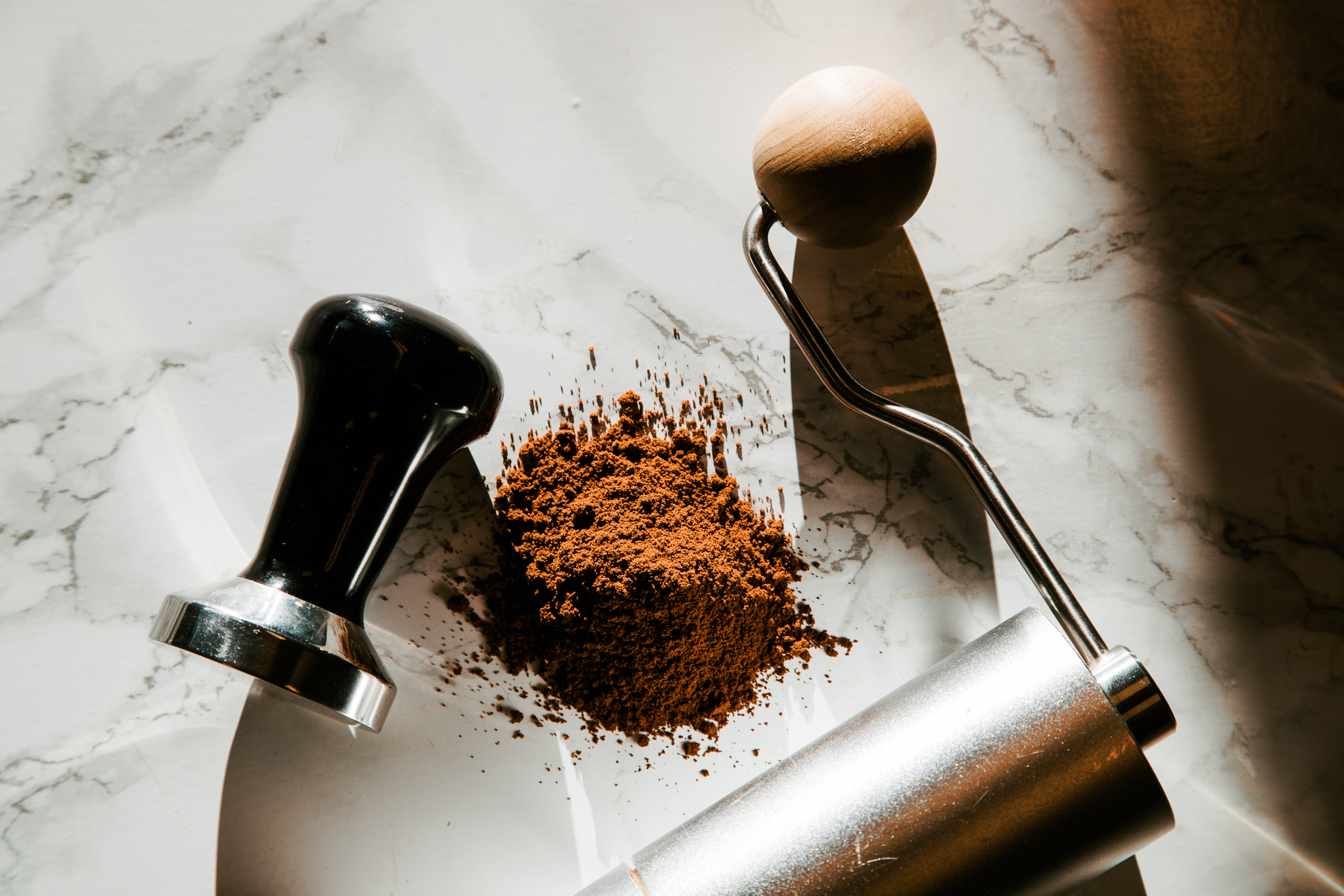
Dose: Most espresso brewed anywhere today would be considered a “double shot”, producing around 2 fl oz of liquid espresso. To brew a double espresso you’ll most ideally use something in the range of 18–21g of ground coffee; when deciding on how large of a dose to use, your first consideration should be the dose recommended by the manufacturer of your basket. Check the sides of your basket for a printed mass measurement and try to stay within 1g of that number for the best results. If you have a basket that doesn’t make a recommendation outside of “single” and “double” go ahead and pick your favorite number between 18 and 21 for a double and we’ll start there in your double basket.
Tamp: Compacting ground coffee with a tamper restricts the flow of water, forcing coffee and water to interact with appropriate pressure. Your tamping action should be firm and even, aiming to compact the coffee entirely without applying unnecessary force; think of it this way, once the coffee is compacted completely there’s no benefit to tamping any harder than that, all you can accomplish at that point is adding more strain to your arm and back! I think of it as “press until the coffee pushes back”, but you could always get out the bathroom scale and press on it to get an idea of 30–40lbs feels like, that should be plenty of weight to reach total compaction.
Temperature: The SCA standard for coffee brewing requires water to be 195–205° F (90.5–96° C), so that’s certainly a good range to start with. Some espresso machines will give you an obvious control and display for your brewing temperature if you’d like to experiment with the impact of different brewing temperatures on your extractions. If there isn’t an obvious control on your machine go ahead and assume that you’re in the ballpark and we can focus on adjusting other variables to dial in your shots.
Yield: When brewing drip coffee we measure coffee input and water input to refer to our brewing ratio, but for espresso brewing ratios we measure coffee input and beverage output. Typically, modern espresso is brewed around a 1:2 ratio, meaning that if you start with 20g of ground coffee in your basket you should aim for something like 40g of brewed espresso in your cup. There’s certainly room to play near that ratio, but if you start venturing outside of 1:1.5–1:2.5 (20g:30g–20g:50g) you’re definitely charting your own course to flavor country.
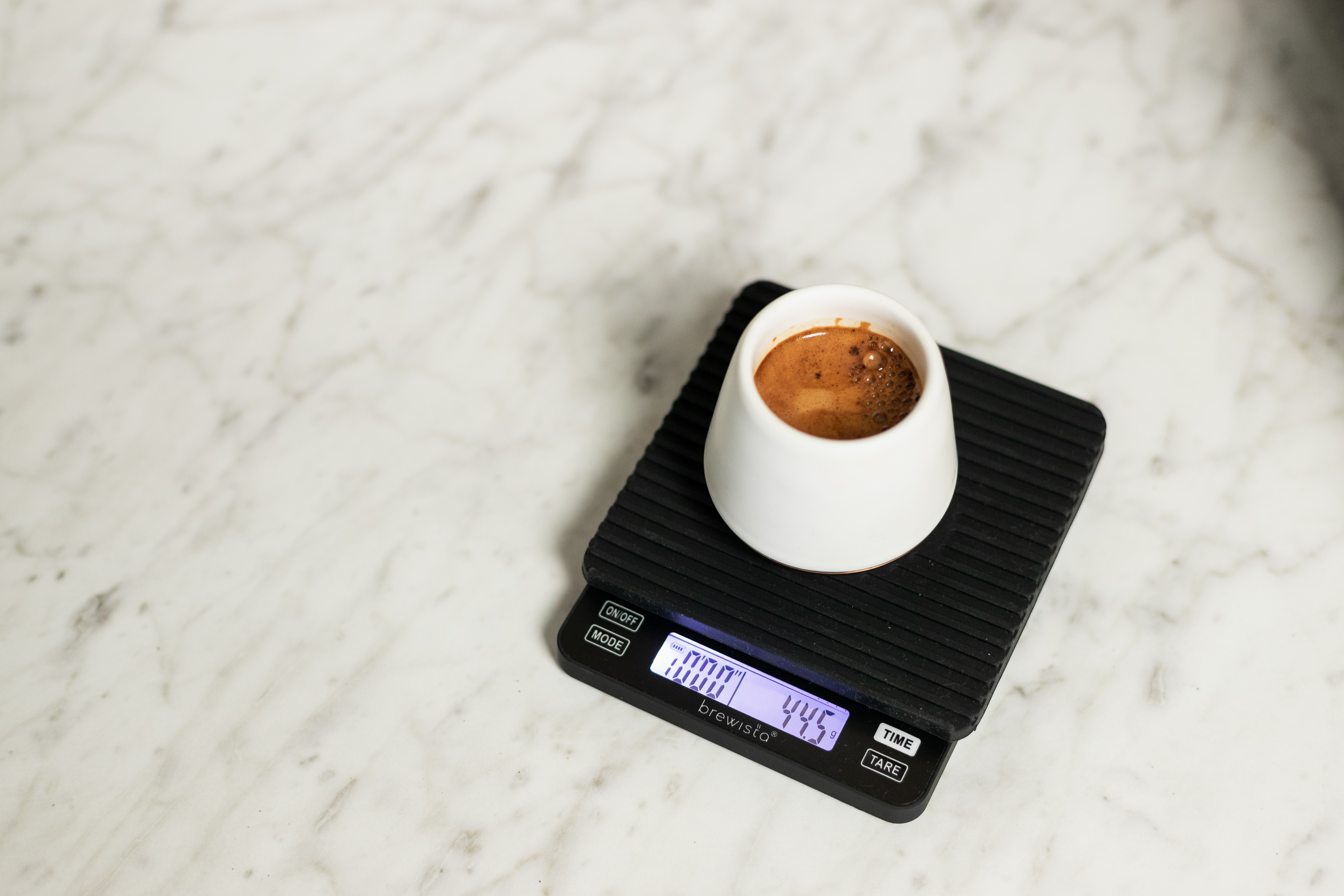
Note: Measuring your beverage output in grams on an accurate scale is best practice for espresso and will be immeasurably more consistent than relying on volumetric measurement. Getting an accurate volumetric reading of such a small amount of liquid presents challenges of its own, but making it even more challenging is the variable density of brewed espresso from coffee to coffee and even from day to day. Crema—that classic indicator of fresh and properly brewed espresso—is an emulsion of gasses trapped in coffee oils; as roasted coffee ages it off-gasses (releasing CO2 trapped in the bean fibers), decreasing the amount of gas available to become crema. As this happens, you end up with less and less crema over time, until eventually the coffee becomes stable (once it has off-gassed all it can). This means that the volume of crema will decrease from day to day, leaving your beverage more dense as that happens. This is why measuring your extraction by volume is wildly inconsistent—day after day if you brew a full 2 fl oz into your shot glass you’ll actually be extracting more and more coffee each time.
Time: Time measures the total contact time between your espresso puck and brew water, beginning from the time that you engage the pump (or you begin preinfusion) and the time that you turn the pump off. Most coffees will thrive when brewed in the 25–35 second range for a typical extraction. If you lean too far outside of this range you’ll likely veer into under-extracted or over-extracted coffee.
Tools of the Trade
All espresso requires a few tools, and if you want consistently delicious and repeatable shots you’ll need just a couple extra pieces of kit to make sure you’re brewing up the good stuff time and time again.

Machine: With so many espresso machines available today it can seem overwhelming to make sense of which one is the right choice for you. The requirements for home users tend to be more forgiving than in cafe environments (you won't typically have to make 20 drinks in an hour at home I imagine!), but looking for a machine that will provide appropriate temperature and consistent pressure is important no matter the setting you'll be in while you're slinging shots. On the more affordable end of the spectrum you might consider a simple lever espresso maker on which you manage the temperature and pressure in a hands-on way. As you climb in price toward electric machines you'll typically see single-boiler machines (either working as a heat exchange machine or as a single-boiler/dual-use machine) made primarily for making a few drinks at a time, though some of these machines still do a great job with consistent pressure at home. Those mid-range machines typically come with a reservoir and drip tray that you'll have to keep an eye to fill and drain yourself, and depending on the kind of boiler in the machine you may have to sacrifice the ability to pull espresso and steam milk simultaneously. After the $2,000 mark you start to see machines fitted with more cafe-quality features—dual-boiler operation, multiple PID controls for temperature management, the option to plumb directly into a water line and drain, high-quality rotary pumps for increased pressure consistency and extended life, and even smaller creature comforts like cool-touch steam wands or beautifully customizable exteriors in any color or material you can dream of.
Grinder: Quality espresso starts with an exceedingly consistent grind. For espresso, be sure that you’re using a burr grinder and NOT a blade grinder, and be sure that your grinder is meant to grind at a fine enough setting for the task. You'll find the most success with grinders that give you tons of tiny stepped adjustments or a fully stepless adjustment for the most control over your extraction. There are finally some hand grinders that make espresso at home possible for a relatively affordable price if you're willing to invest some elbow grease. As you graduate into nicer electric grinders for home you'll see increased grinding speeds, programmable operation, and larger burr sets made to handle espresso a bit more easily than some of the smaller options out there. It has to be said—your grinder is not the piece of equipment to try to skimp and save a little money on. While there are plenty of espresso machines that can provide the temperature and pressure necessary for extraction, your grind quality and consistency are maybe the most important variables for delicious espresso. This means that high-quality burrs AND high-quality construction are an absolute requirement for good espresso, so it can be difficult to find a workable espresso grinder (manual or electric) for much under $200—this might seem outlandish, but I promise that if you take my advice on this now you'll thank me later. .
Filter: The filter for espresso in many ways will be your portafilter basket. Your espresso machine may have arrived with a few different basket options, from which we recommend your “double” basket, or the one rated for 18–21g of coffee. If you’re looking for even more consistent quality you can consider investing in a precision basket, which are designed and manufactured to ensure consistent hole placement and total-open-area based on its recommended coffee dose.
Tamper: For the best and most consistent results select a tamper that is sized to fit snugly in your portafilter basket. With the variety of styles, sizes, and prices available today, it will likely be easiest to decide which style you prefer—traditional or palm—and then look at your options from there.
Scale: Using a scale to measure both coffee input and beverage output is highly recommended to make consistent espresso. We prefer scales that are highly precise (0.1g resolution is wonderful, though even 1g resolution is workable) and have a quick refresh rate, with a tendency to love water-resistant scales considering you’ll be brewing straight onto it.
Vessel: You’ll need something to brew into of course! A demitasse, shot glass, gibraltar, it really doesn’t matter particularly, just be sure that it’s large enough to catch your full extraction.
Alright, let’s brew!
How to Make Espresso
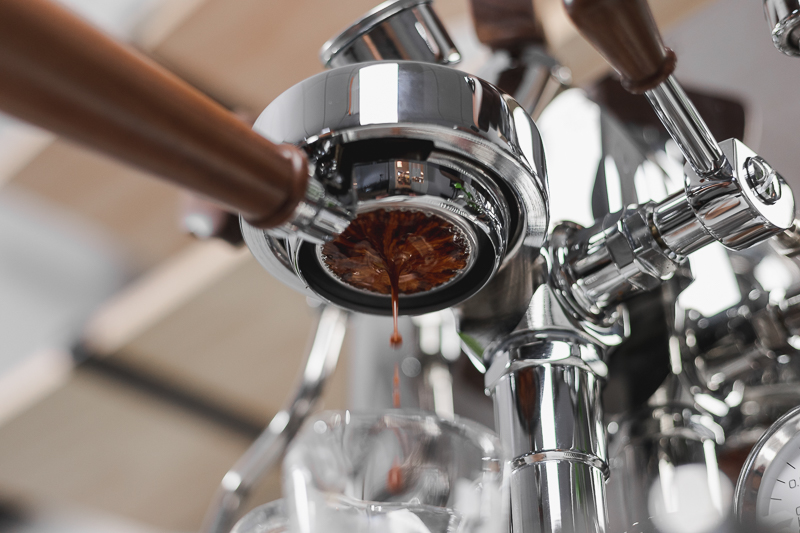
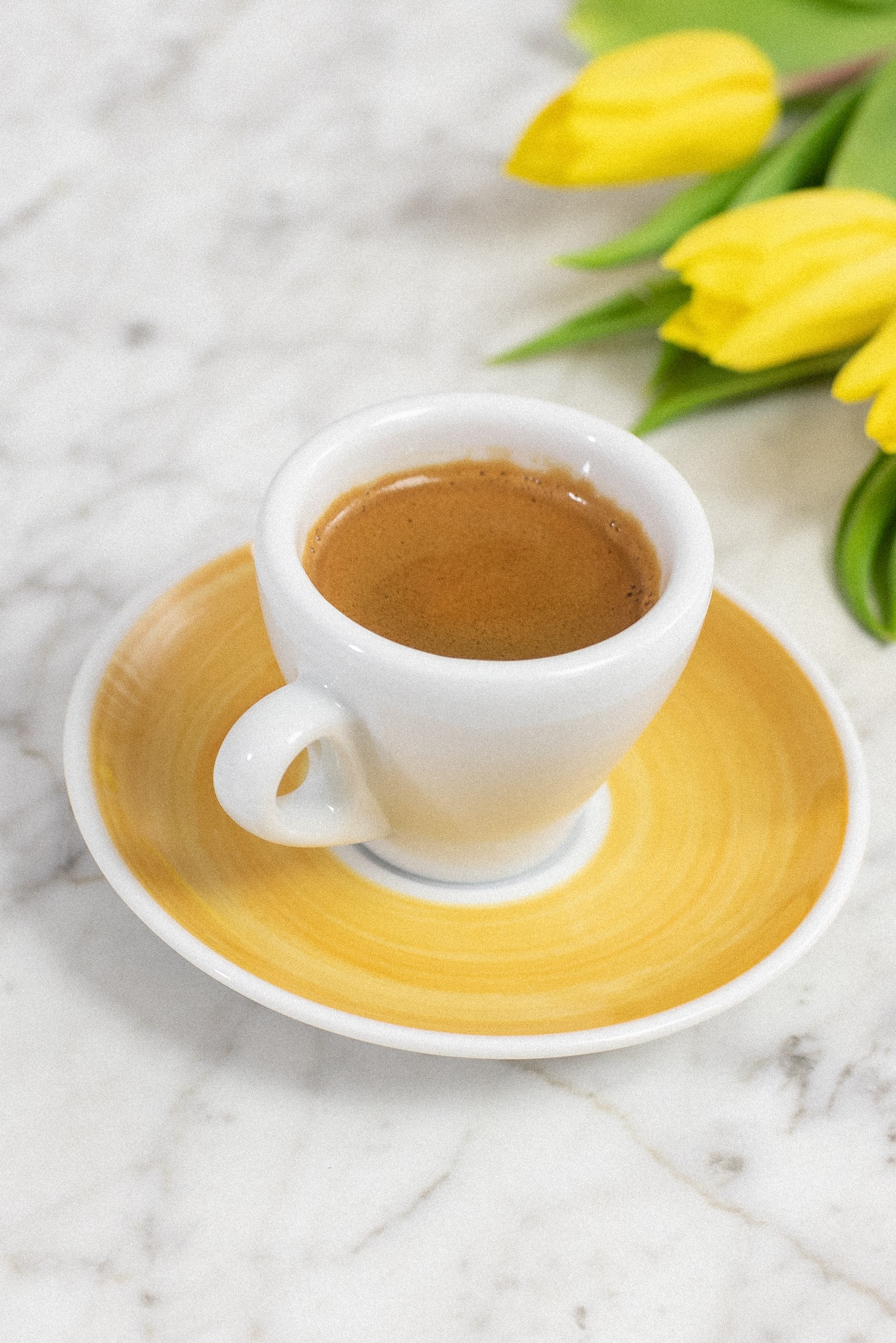
- Fill your espresso machine’s reservoir or hook up its water line, be sure that the water you use matches up with our “Water” explanation in the “Brewing Variables” section above.
- Turn your machine on and give it plenty of time to heat up. This could take anywhere from 15–45 minutes, so relax and let the machine get fully up to temp. If you have a temperature display on your machine, be sure that once your water reaches your brewing temp that you allow the rest of the machine to continue heating until the rest of it is up to steady operational temperature—this can include the group head, portafilter, and any other internal components that require more energy than water does to reach a stable temperature. Once heated, let the group run for a few seconds to purge any stale water from the group.
- Check the fineness of your grind by running a few beans through your grinder. Remember that you’ll need very finely ground coffee, likely a bit finer than table salt.
- Grind coffee into your portafilter basket, typically 18–21g as determined by the dose your basket is made for. Aim to settle and distribute ground coffee evenly throughout the basket prior to tamping, either using a manual tapping/shaking/settling method or by using a distribution tool.
- Tamp your coffee dose firmly, aiming to be as even as possible with your tamper. If you're using a traditional tamp be sure to do your best to keep your wrist, arm, and elbow all in line over the center of the basket while tamping—this will help you avoid unnecessary strain and will keep the force of your tamp distributed evenly across the whole basket.
- Lock your portafilter into the grouphead carefully, being sure not to knock the portafilter against anything to prevent dislodging or cracking the coffee puck. Position your vessel and scale below the portafilter and start the brew, either by engaging your pre-infusion setting or by engaging the pump to begin brewing.
- Stop the pump just before your extraction reaches your desired yield and let the last few drips out of the portafilter finish your brew.
- Simply stir, sip, and enjoy if you’re just making a shot, or mix the espresso with your other ingredients to build your tasty beverage.
- Knock the spent espresso puck out of your portafilter. Flush the grouphead to rinse debris and coffee oils from the screen, and wipe out your basket to keep it free of debris and grime as well.
Espresso Tips and Troubleshooting
Even when you do everything correctly espresso can still be a challenge. If your brew isn’t everything you had expected, or if it clearly didn’t go the way it was supposed to, read on to see some simple fixes to common espresso problems.
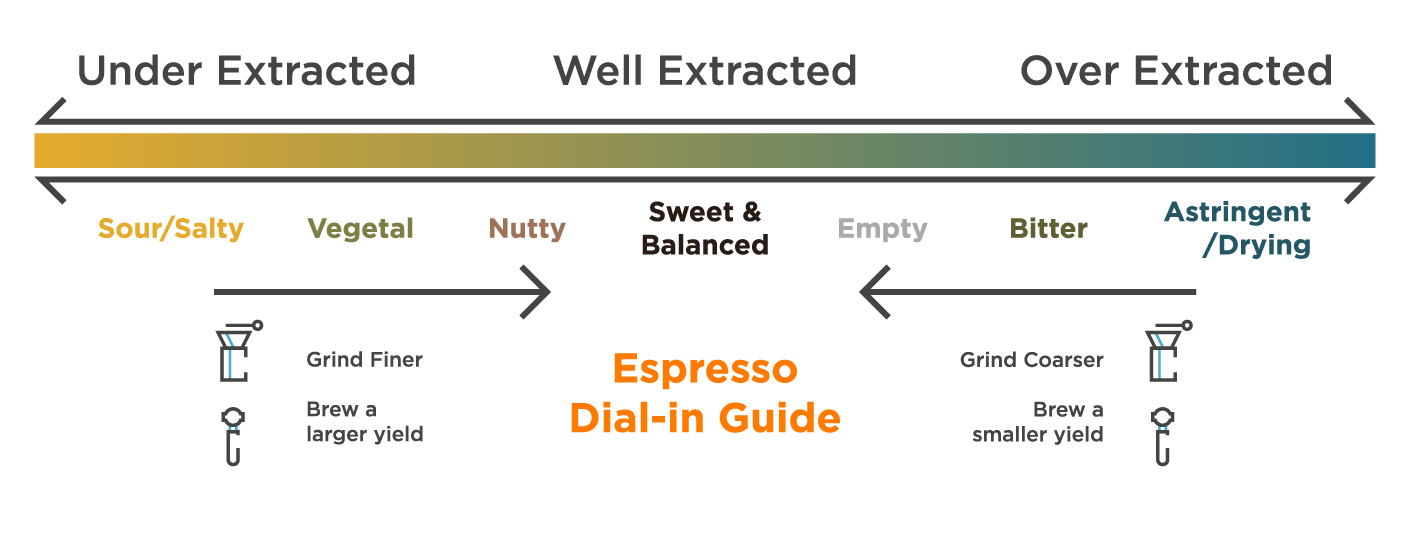
My shot took too long/there’s no coffee flowing out of the portafilter.
- Grind coarser.
- Ensure that your dose isn’t too large for the basket. If you see the impression of the machine’s screen on your puck you should decrease your dose.
My shot ran too quickly.
- Grind finer.
- Ensure that your dose isn’t too small for the basket. If your dry tamped coffee puck fills less than half of your basket’s volume you should increase your dose.
My shot tastes bitter.
This is most likely caused by over-extraction. You could:
- Reduce your brew ratio (if you extracted 40g of beverage, for example, try 36g) or,
- Grind coarser to reduce your brew time.
My shot tastes sour.
- This is most likely under-extraction. You could:
- Increase your brew ratio (if you extracted 40g for example, try 44g) or,
- grind finer to extend your brew time.
My espresso is watery
Espresso requires appropriate brewing ratio, time, and temperature in order to have its characteristically luscious texture. To address a thin espresso:
- Decrease your brew ratio
- Grind finer
- Check for uneven tamping
- Check for signs of channeling (fissures or pinholes in your coffee puck after extraction)
- Ensure your water quality is correct, and at the correct temperature.
My espresso’s stream is uneven
Water will always follow the path of least resistance through the portafilter. If the puck isn’t level or is seated improperly, water will flow unevenly through the puck. To address this:
- Ensure even distribution AND
- Ensure your tamp is level
In this article we talk about steaming milk and making classic café drinks like cappuccinos, lattes, and americanos.
How’s making espresso going for you? What questions do you have that we didn’t get to address here? What successes are you having? Have you pulled that perfect, transcendent shot yet? If not, check out our community where you can take one of our courses and chat with like-minded coffee enthusiasts about making the perfect coffee.
